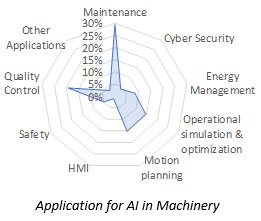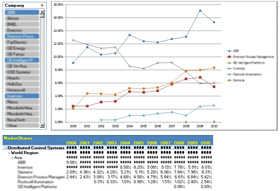

The artificial intelligence (AI) for machinery applications report gives an overview of the technology, application, and markets for AI on the machinery level. The research is based on 40 plus expert interviews plus an online survey. We feature market size, as well as strategies for adoption and go into a deep dive on individual machinery segments.
Around 2009, people began talking about the fourth industrial revolution, Industrial IoT, and other related concepts. However, in retrospect, the second and third industrial revolutions largely just replaced human muscle and manual labor with machines and computers that basically repeat pre-programmed behavior. While the fourth industrial revolution increased the level of digitalization, until recently, even the most educated machines and computers did not make human-like decisions. Now, with AI entering the plant floor, we’re finally starting to use digital technology to replace not only muscles but also brains. Most experts agree that while AI will become deeply embedded across industrial and other applications and initial use cases have emerged, AI in manufacturing today is still a niche technology.
 Today, depending on your perspective, your thoughts on AI probably fall somewhere between the technology being an abstract threat or possibility, and a real-world solution with concrete use cases where you may not even know it is at work. In the future, AI will be so deeply embedded in everyday life and in automation that we won’t even recognize that it is there for most of the time.
Today, depending on your perspective, your thoughts on AI probably fall somewhere between the technology being an abstract threat or possibility, and a real-world solution with concrete use cases where you may not even know it is at work. In the future, AI will be so deeply embedded in everyday life and in automation that we won’t even recognize that it is there for most of the time.
In order to enable something that groundbreaking, it is crucial to identify the right solution for the right machine type. Machine tools offer other possibilities; other than robots or material handling applications—and not only are the applications different, but also the AI techniques used. The report features these characteristics, next to the individual market potential, and also lists a number of strategies of how to deal with the most common roadblocks, when implementing AI.
 In addition to providing a five-year market forecast, the AI for machinery applications market research provides detailed quantitative current market data and addresses key strategic issues as follows.
In addition to providing a five-year market forecast, the AI for machinery applications market research provides detailed quantitative current market data and addresses key strategic issues as follows.
This market study may be purchased as an Excel Workbook and/or as a concise, executive-level Market Analysis Report (PDF). The Workbook has some unique features such as the ability to select local currency. Studies and formats available are listed below:
| MIRA Workbook | Market Analysis PDF | |
| Worldwide (includes regional data) | Yes | Yes |
The research identifies all relevant suppliers serving this market.
For more information or to purchase the AI in Machinery study, please contact us.

